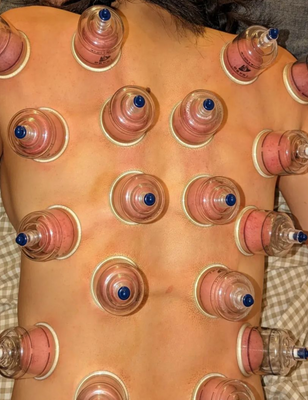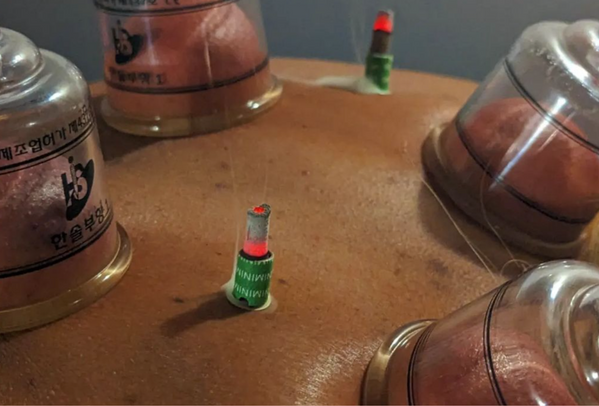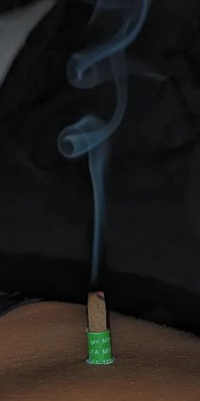I encourage holistic health and wellness, specializing in offering a range of therapies, including cupping and moxibustion therapy. I use traditional wet and dry cupping techniques alongside modern practices to provide safe and effective treatment tailored to clients' needs.
Cupping therapy can address various conditions from muscle tension and pain I encourage holistic health and wellness, specializing in offering a range of therapies, including cupping and moxibustion therapy. I use traditional wet and dry cupping techniques alongside modern practices to provide safe and effective treatment tailored to clients' needs.
Cupping therapy can address various conditions from muscle tension and pain to blood circulation to blood circulation issues and skin health. I trust in the power of cupping therapy to promote physical (and emotional) healing and am committed to creating a welcoming and supportive environment for my clients.
My goal is to provide a safe and affirming space where individuals of all genders, races, and backgrounds can receive compassionate and effective care. Whether you are seeking relief from chronic pain, a specific ache, improvement in athletic performance, or simply aiming for greater overall well-being, I am here to support you.
Contact me via email to learn more about my services and book your consultation/appointment.
Disclaimer:
I am not a licensed medical professional or certified healthcare provider. My cupping and wellness services are rooted in traditional techniques passed down through my family and over 10 years of hands-on experience. These treatments are offered for relaxation, wellness, and general well-being, and are not intended to diagnose, treat, or cure any medical conditions. Please consult with a licensed healthcare provider for any medical concerns.



FAQ
What is cupping therapy?
Cupping therapy is an alternative therapy that involves placing cups on the skin to create suction. This suction is thought to help stimulate blood flow, reduce pain and inflammation, and promote relaxation.
Cupping therapy is an alternative therapy that involves placing cups on the skin to create suction. This suction is thought to help stimulate blood flow, reduce pain and inflammation, and promote relaxation.
What are the cups used for cupping made of?
Cups used for cupping are typically made of glass, silicone, or plastic. The ones that I use are plastic.
Cups used for cupping are typically made of glass, silicone, or plastic. The ones that I use are plastic.
What does cupping feel like?
Cupping can feel like a deep tissue massage or a pulling sensation on the skin. Some people find it to be a relaxing experience, while others may find it uncomfortable or painful.
Cupping can feel like a deep tissue massage or a pulling sensation on the skin. Some people find it to be a relaxing experience, while others may find it uncomfortable or painful.
What are the different types of cupping?
There are several types of cupping, including dry cupping, wet cupping, and fire cupping. I currently offer dry and wet cupping. I may offer fire cupping in the future, please inquire if interested.
There are several types of cupping, including dry cupping, wet cupping, and fire cupping. I currently offer dry and wet cupping. I may offer fire cupping in the future, please inquire if interested.
Is cupping safe?
Cupping is generally considered safe. However, as with any medical or alternative therapy, there may be risks and side effects, particularly for individuals with certain medical conditions or skin sensitivities. Please let me know if you have any medical conditions or history I should be aware of before we meet.
Cupping is generally considered safe. However, as with any medical or alternative therapy, there may be risks and side effects, particularly for individuals with certain medical conditions or skin sensitivities. Please let me know if you have any medical conditions or history I should be aware of before we meet.
What are the benefits of cupping?
* Pain relief: Cupping may help with pain relief, improved circulation, relaxation, improved immune function, and detoxification.
* Reduced muscle tension: Cupping can help relieve muscle tension by increasing blood flow and promoting relaxation.
* Improved athletic performance: Some athletes believe that cupping can help improve their performance by reducing muscle soreness and improving their range of motion.
* Relief from headaches and migraines: Cupping may help reduce the frequency and severity of headaches and migraines by improving circulation and reducing muscle tension.
* Improved skin health: Cupping can help stimulate the production of collagen and elastin, which are important for maintaining healthy skin. Cupping may also be effective for people who have eczema.
* Relief from respiratory issues: Cupping may help improve respiratory function by reducing inflammation and promoting relaxation.
* Improved digestion: Cupping may help improve digestion by stimulating the digestive system and reducing inflammation in the gut.
* Relief from menstrual cramps: Cupping may help relieve menstrual cramps by reducing muscle tension and improving circulation.
* Improved sleep: Cupping may help promote relaxation, reduce stress, and alleviate pain or discomfort that may interfere with sleep, potentially improving sleep quality in some individuals.
* Pain relief: Cupping may help with pain relief, improved circulation, relaxation, improved immune function, and detoxification.
* Reduced muscle tension: Cupping can help relieve muscle tension by increasing blood flow and promoting relaxation.
* Improved athletic performance: Some athletes believe that cupping can help improve their performance by reducing muscle soreness and improving their range of motion.
* Relief from headaches and migraines: Cupping may help reduce the frequency and severity of headaches and migraines by improving circulation and reducing muscle tension.
* Improved skin health: Cupping can help stimulate the production of collagen and elastin, which are important for maintaining healthy skin. Cupping may also be effective for people who have eczema.
* Relief from respiratory issues: Cupping may help improve respiratory function by reducing inflammation and promoting relaxation.
* Improved digestion: Cupping may help improve digestion by stimulating the digestive system and reducing inflammation in the gut.
* Relief from menstrual cramps: Cupping may help relieve menstrual cramps by reducing muscle tension and improving circulation.
* Improved sleep: Cupping may help promote relaxation, reduce stress, and alleviate pain or discomfort that may interfere with sleep, potentially improving sleep quality in some individuals.
How long does a cupping session last?
A cupping session typically lasts between 30-90 minutes, although the exact duration varies depending on the specific type of cupping being performed.
A cupping session typically lasts between 30-90 minutes, although the exact duration varies depending on the specific type of cupping being performed.
How often should I get cupping therapy?
The frequency of cupping therapy depends on the individual's needs and the condition being treated. Some people may benefit from weekly or bi-weekly sessions, while others may only need occasional treatments. I am happy to discuss the frequency of treatment during our initial consultation.
The frequency of cupping therapy depends on the individual's needs and the condition being treated. Some people may benefit from weekly or bi-weekly sessions, while others may only need occasional treatments. I am happy to discuss the frequency of treatment during our initial consultation.
Who would benefit from cupping?
Cupping therapy can potentially benefit a wide range of people, including those who:
* Experience chronic pain: Cupping therapy has been used to help alleviate chronic pain conditions such as fibromyalgia, back pain, and neck pain.
* Have muscle tension: Cupping therapy can help relieve muscle tension by increasing blood flow and promoting relaxation.
* Experience headaches and migraines: Cupping therapy may help reduce the frequency and severity of headaches and migraines by improving circulation and reducing muscle tension.
* Experience respiratory issues: Cupping therapy may help improve respiratory function by reducing inflammation and promoting relaxation.
* Have digestive issues: Cupping therapy may help improve digestion by stimulating the digestive system and reducing inflammation in the gut.
* Experience menstrual cramps: Cupping therapy may help relieve menstrual cramps by reducing muscle tension and improving circulation.
* Are athletes: Cupping therapy may help improve athletic performance by reducing muscle soreness and improving range of motion.
* Want to improve their skin health: Cupping therapy can help stimulate the production of collagen and elastin, which are important for maintaining healthy skin. Cupping may also be helpful for those who have eczema.
Cupping therapy can potentially benefit a wide range of people, including those who:
* Experience chronic pain: Cupping therapy has been used to help alleviate chronic pain conditions such as fibromyalgia, back pain, and neck pain.
* Have muscle tension: Cupping therapy can help relieve muscle tension by increasing blood flow and promoting relaxation.
* Experience headaches and migraines: Cupping therapy may help reduce the frequency and severity of headaches and migraines by improving circulation and reducing muscle tension.
* Experience respiratory issues: Cupping therapy may help improve respiratory function by reducing inflammation and promoting relaxation.
* Have digestive issues: Cupping therapy may help improve digestion by stimulating the digestive system and reducing inflammation in the gut.
* Experience menstrual cramps: Cupping therapy may help relieve menstrual cramps by reducing muscle tension and improving circulation.
* Are athletes: Cupping therapy may help improve athletic performance by reducing muscle soreness and improving range of motion.
* Want to improve their skin health: Cupping therapy can help stimulate the production of collagen and elastin, which are important for maintaining healthy skin. Cupping may also be helpful for those who have eczema.
Who should not receive cupping?
* People with skin ulcers, edema, or other skin conditions: Cupping can irritate the skin, and it should not be applied to areas of the skin that are already damaged or inflamed.
* Pregnant women: While there is limited research on the safety of cupping during pregnancy, it is generally recommended that pregnant women avoid cupping therapy, particularly in the abdominal and lower back areas.
* People who are prone to bleeding: Cupping can cause small blood vessels near the surface of the skin to rupture, so it should not be performed on individuals who have bleeding disorders or who are taking blood-thinning medications.
* People with a history of strokes or seizures: Cupping can sometimes trigger seizures in individuals with a history of epilepsy or other seizure disorders.
* People with liver, kidney, or heart failure, or those with a pacemaker.
* People with skin ulcers, edema, or other skin conditions: Cupping can irritate the skin, and it should not be applied to areas of the skin that are already damaged or inflamed.
* Pregnant women: While there is limited research on the safety of cupping during pregnancy, it is generally recommended that pregnant women avoid cupping therapy, particularly in the abdominal and lower back areas.
* People who are prone to bleeding: Cupping can cause small blood vessels near the surface of the skin to rupture, so it should not be performed on individuals who have bleeding disorders or who are taking blood-thinning medications.
* People with a history of strokes or seizures: Cupping can sometimes trigger seizures in individuals with a history of epilepsy or other seizure disorders.
* People with liver, kidney, or heart failure, or those with a pacemaker.
What are some important tips I should consider before getting cupping therapy?
Prepare your mind and body for optimal reception of cupping therapy and help ensure a safe and effective treatment experience by following these recommendations:
Prepare your mind and body for optimal reception of cupping therapy and help ensure a safe and effective treatment experience by following these recommendations:
1. Hydrate: Drinking plenty of water before and after cupping therapy can help improve the effectiveness of the treatment and reduce the risk of dehydration.
2. Avoid heavy meals: Eating a heavy meal immediately before cupping therapy may cause discomfort or nausea during the treatment. It's recommended to eat a light meal or snack at least one hour before the session.
3. Wear comfortable clothing: Loose-fitting clothing that can be easily adjusted or removed is recommended for cupping therapy. This can help ensure that the cups can be properly placed on the skin and that the client is comfortable during the treatment.
4. Communicate with your practitioner: It's important to communicate any health concerns or discomfort to your practitioner before and during the treatment. This can help ensure that the treatment is safe and effective.
5. Prepare for relaxation: Cupping therapy can be a deeply relaxing experience. It may be helpful to prepare for the treatment by practicing relaxation techniques such as deep breathing or meditation.
6. Be aware of potential side effects: While cupping therapy is generally safe, it can cause mild side effects such as temporary skin discoloration or soreness. It's important to be aware of these potential side effects and to report any concerns to your practitioner.
7. It is generally not recommended to receive cupping therapy when under the influence of alcohol or suffering from a hangover. Alcohol can affect blood flow and circulation, and receiving cupping therapy while under the influence of alcohol may increase the risk of adverse effects such as dizziness, nausea, or fainting. Additionally, hangovers can cause dehydration and sensitivity to touch, making cupping therapy uncomfortable or even painful. It's best to wait until you are feeling better and sober before receiving cupping therapy.
If you have any other questions or concerns, please feel free to reach out and ask me. Otherwise, we can discuss this in person during our consultation/sessions.